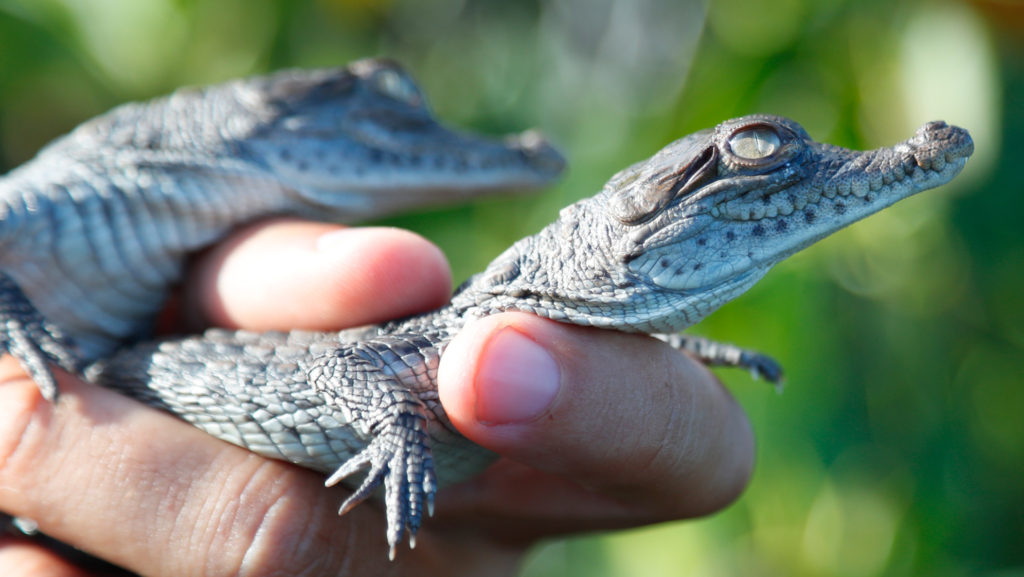Look Out, KB: Crocodiles Thriving at Turkey Point
Wire and Staff ReportsJuly 22, 2019

Wildlife biologist/crocodile specialist Michael Lloret releases baby crocodiles back into the wild along the cooling canals next to the Turkey Point Nuclear Generating Station after having measured and tagged them with microchips to observe their development in the future, Friday, July 19, 2019, in Homestead, Fla. The 168-miles of man-made canals serve as the home to several hundred crocodiles, where a team of specialists working for Florida Power and Light (FPL) monitors and protects the American crocodiles. (AP Photo/Wilfredo Lee)
Don’t look now, Key Biscayne, but a rare crocodile sighting that lit up local social media a few weeks ago might be a sign of things to come.
That’s because American crocodiles, once headed toward extinction, are thriving at an unusual spot — the canals surrounding a South Florida nuclear plant.
Last week, 73 crocodile hatchlings were rescued by a team of specialists at Florida Power & Light’s Turkey Point nuclear plant and dozens more are expected to emerge soon.
While there is no way to know if the hatchlings will make it to Key Biscayne, it’s not uncommon for American crocodiles to roam.
A lot.
In 2013, an 11-foot croc that was born in 1999 near Turkey Point was captured in Lake Tarpon in Pinellas County, 350 miles away and on the other side of the state, the Tampa Bay Times reported. It took four hours to trap the crocodile.
By comparison, the 10-mile swim from Turkey Point to Key Biscayne looks downright leisurely.
“Crocodiles are certainly making a comeback and can be seen from Key Biscayne to Key Largo. It is very possible (even probable) that some of these crocodiles are originating from the Turkey Point population,” said Ron Magill, a wildlife expert and spokesman for Zoo Miami.
Turkey Point’s 168 miles of man made canals serve as the home to several hundred crocodiles, and a team of specialists working for FPL monitors and protects them from hunting and climate change.
From January to April, Michael Lloret, an FPL wildlife biologist and crocodile specialist, helps create nests and ponds on berms for crocodiles to nest. Once the hatchlings are reared and left by the mother, the team captures them. They are measured and tagged with microchips to observe their development. Lloret then relocates them to increase survival rates.
“We entice crocodiles to come in to the habitats FPL created,” Lloret said. “We clear greenery on the berms so that the crocodiles can nest. Because of rising sea levels wasting nests along the coasts, Turkey Point is important for crocodiles to continue.”
The canals are one of three major U.S. habitats for crocodiles, where 25% of the 2,000 American crocodiles live. The FPL team has been credited for moving the classification of crocodiles under the Endangered Species Act to “threatened” from “endangered” in 2007. The team has tagged 7,000 babies since it was established in 1978.
Temperature determines a crocodile’s sex: the hotter it is the more likely males are hatched. Lloret said this year’s hatchlings are male-heavy due to last month being the hottest June on record globally.
Because released hatchlings are at the bottom of the food chain, only a small fraction survive to be adults. Lloret said they at least have a fighting chance at Turkey Point, away from humans who hunted them to near-extinction out of greed and fear even though attacks are rare. Only one crocodile attack has ever been recorded in the United States — a couple were both bitten while swimming in a South Florida canal in 2014, but both survived.
“American crocodiles have a bad reputation when they are just trying to survive,” Lloret said. “They are shy and want nothing to do with us. Humans are too big to be on their menu.”
Will more crocs come to Key Biscayne? Most likely, said Magill, the Zoo Miami expert
“As that population continues to grow and reach sexual maturity, subordinate individuals will be forced out to seek their own territories,” Magill said. “it does not surprise me to see these individuals turning up in areas where there previously were none.”
If you see a crocodile, stay away and call the Florida Fish and Wildlife Conservation Commission at 1-866-FWC-GATOR to be put into contact with a biologist.
Associated Press reporter Marcos Lim and Key News Tony Winton contributed to this story.


